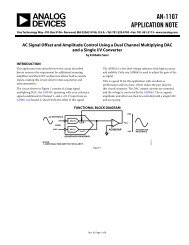EE Web PULSE
EE Web PULSE
EE Web PULSE
You also want an ePaper? Increase the reach of your titles
YUMPU automatically turns print PDFs into web optimized ePapers that Google loves.
TECHNICAL ARTICLE<br />
CLCxIN[0]<br />
CLCxIN[1]<br />
CLCxIN[2]<br />
CLCxIN[3]<br />
CLCxIN[4]<br />
CLCxIN[5]<br />
CLCxIN[6]<br />
CLCxIN[7]<br />
Figure 2<br />
Input Data Selection Gates<br />
See Figure 19-2<br />
lcxg1<br />
lcxg2<br />
lcxg3<br />
lcxg4<br />
See Figure 19-3<br />
Logic<br />
Function<br />
LCxMODE<br />
LCxEN<br />
lcxg<br />
LCxPOL<br />
lcx_out<br />
Interrupt<br />
det<br />
LCxINTP<br />
LCxINTN<br />
Interrupt<br />
det<br />
Q1 LE<br />
LCxOE<br />
LCxOUT<br />
inputs that can come from I/O pins, internal clocks,<br />
Peripherals, or even from register bits. These inputs can<br />
then be passed through one of a number of pre-configured<br />
logic blocks that perform functions like AND-OR, S-R,<br />
J-K and D type flip-flops. What’s then quite nice is that an<br />
external pin can be driven directly from this output, read<br />
internally, or it can even generate an interrupt. It may not<br />
have the flexibility and programmability of, say, a FPGA<br />
LAB, but I can see these becoming very useful glue logic<br />
tools for embedded engineers.<br />
CLCxIN[0]<br />
CLCxIN[1]<br />
CLCxIN[2]<br />
CLCxIN[3]<br />
CLCxIN[4]<br />
CLCxIN[5]<br />
CLCxIN[6]<br />
CLCxIN[7]<br />
CLCxIN[0]<br />
CLCxIN[1]<br />
CLCxIN[2]<br />
CLCxIN[3]<br />
CLCxIN[4]<br />
CLCxIN[5]<br />
CLCxIN[6]<br />
CLCxIN[7]<br />
CLCxIN[0]<br />
CLCxIN[1]<br />
CLCxIN[2]<br />
CLCxIN[3]<br />
CLCxIN[4]<br />
CLCxIN[5]<br />
CLCxIN[6]<br />
CLCxIN[7]<br />
CLCxIN[0]<br />
CLCxIN[1]<br />
CLCxIN[2]<br />
CLCxIN[3]<br />
CLCxIN[4]<br />
CLCxIN[5]<br />
CLCxIN[6]<br />
CLCxIN[7]<br />
Figure 3<br />
000<br />
111<br />
000<br />
111<br />
000<br />
111<br />
000<br />
111<br />
Data Selection<br />
LCxD1S<br />
LCxD2S<br />
LCxD3S<br />
LCxD4S<br />
lcxd1T<br />
lcxd1N<br />
lcxd2T<br />
lcxd2N<br />
lcxd3T<br />
lcxd3N<br />
lcxd4T<br />
lcxd4N<br />
LCxD1G1T<br />
LCxD1G1N<br />
LCxD2G1T<br />
LCxD2G1N<br />
LCxD3G1T<br />
LCxD3G1N<br />
LCxD4G1T<br />
LCxD4G1N<br />
D Q<br />
LCxG1POL<br />
(Same as Data GATE 1)<br />
(Same as Data GATE 1)<br />
(Same as Data GATE 1)<br />
TRIS Control<br />
CLCx<br />
Data GATE 1<br />
Data GATE 2<br />
Data GATE 3<br />
Data GATE 4<br />
sets<br />
CLCxIF<br />
flag<br />
lcxg1<br />
lcxg2<br />
lcxg3<br />
lcxg4<br />
AND - OR OR - XOR<br />
lcxg1 lcxg1<br />
lcxg2<br />
lcxg3<br />
lcxq<br />
lcxg2<br />
lcxg3<br />
lcxg4 lcxg4<br />
LCxMODE=000 LCxMODE=001<br />
4-input AND S-R Latch<br />
lcxg1 lcxg1<br />
lcxg2<br />
lcxg3<br />
lcxq<br />
lcxg2<br />
lcxg3<br />
lcxg4 lcxg4<br />
LCxMODE=010 LCxMODE=011<br />
1-input D Flip-Flop with S and R 2-input D Flip-Flop with R<br />
<strong>EE</strong><strong>Web</strong> | Electrical Engineering Community Visit www.eeweb.com 11<br />
lcxg4<br />
lcxg2<br />
lcxg1<br />
lcxg3<br />
D<br />
S Q<br />
R<br />
lcxq<br />
LCxMODE=100 LCxMODE=101<br />
J-K Flip-Flop with R 1-input Transparent Latch with S and R<br />
lcxg2<br />
lcxg1<br />
lcxg4<br />
lcxg3<br />
Figure 4<br />
J Q<br />
K<br />
R<br />
lcxq<br />
lcxg4<br />
lcxg2<br />
lcxg4<br />
lcxg2<br />
lcxg1<br />
lcxg3<br />
lcxg1<br />
lcxg3<br />
LCxMODE=110 LCxMODE=111<br />
D<br />
LE R<br />
S Q<br />
S Q<br />
D Q<br />
Another nice feature to find in such a small chip is the<br />
Complementary Waveform Generator (CWG). This<br />
allows you generate controllable waveforms for use in a<br />
half bridge or switching power supply for example. The<br />
module allows for selectable input sources and have<br />
some nice and simple auto-shutdown controls. Dead<br />
time is also programmable for both the rise and fall side.<br />
I’ve seen similar modules on the larger chips but found<br />
this much easier to understand and more independent of<br />
the code that may be running on the core.<br />
Both the CLC and CWG could be really nice units if only<br />
you have a clock source that is easy to control and whose<br />
frequency is easy to set. Well the chips now also come<br />
with a Numerically Controlled Oscillator (NCO) that can<br />
be used to feed the above CLC and CWG modules. This<br />
is no Phase Lock Loop (PLL) but will allow for simple<br />
clock division. The module works by having a configured<br />
value added to an accumulator on each clock cycle.<br />
The overflow is then used as a raw output that can be<br />
R<br />
R<br />
lcxq<br />
lcxq<br />
lcxq<br />
lcxq<br />
TECHNICAL ARTICLE















